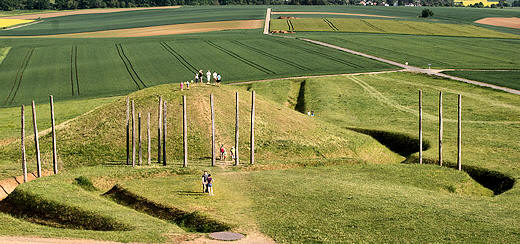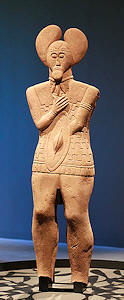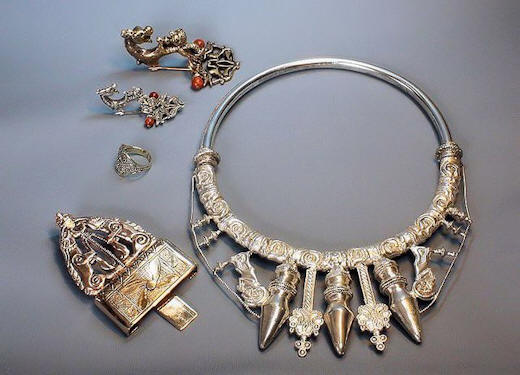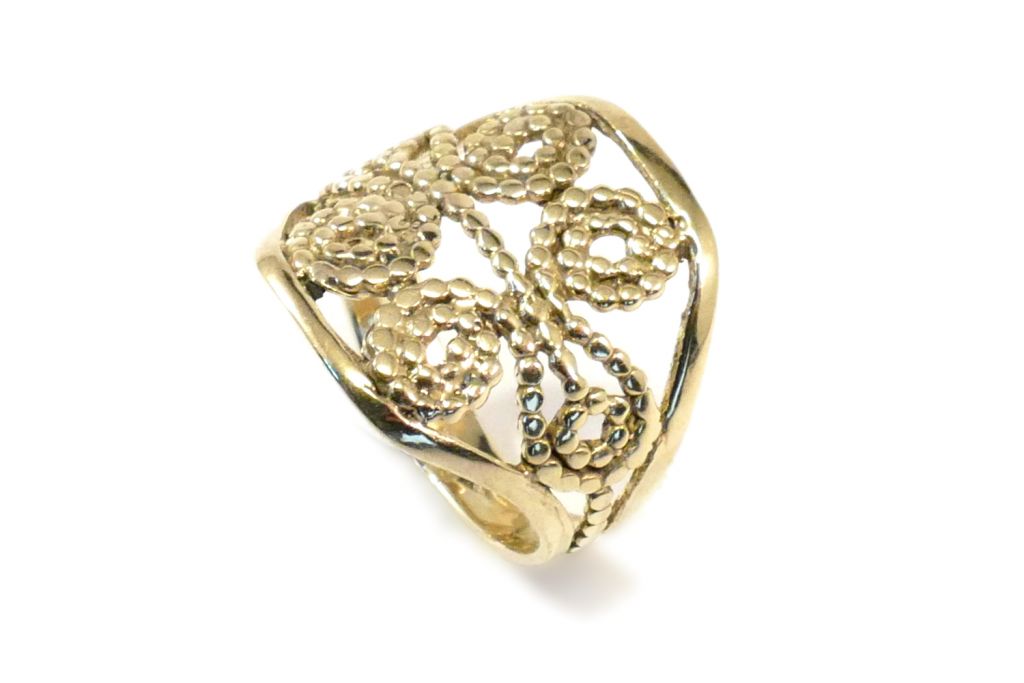Ring Glauberg, Gold 585
Freely worked after motifs of the well-known gold ring from the Glauberg mound no. 1 from the 5th century B.C. Handcrafted from high-quality 585 yellow gold (14 carat).
Ring Glauberg, Gold 585
Our free copy bases on the original gold ring of the famous celtic Glauberg-Burial No. 1 of the 5th century BC. Handmade from high quality 14 Karat Gold (585/1000).
More informations:
Eine Zahlung per Bankeinzug oder auf Rechnung ist bei diesem Schmuckstück leider nicht möglich. Aufgrund des hohen Materialwertes erfolgt der Versand nur nach Vorkasse (Banküberweisung oder PayPal).
Glauberg and the Celtic Prince
The Glauberg - settlement history
The Glauberg has recently become world-famous through the discovery of rich Celtic burials and the statue of the Celtic Prince. Yet these extraordinary finds reflect only a small section of the long settlement history at the Glauberg.
Situated on the eastern edge of the Wetterau, about 30 km north-east of Frankfurt, the Glauberg has always been used by people to settle and build fortifications due to its exposed location. The oldest finds from the approximately 8-hectare high plateau date back to the Palaeolithic period, and the Glauberg has been settled over a wide area since the Neolithic Michelsberg culture in the 4th millennium at the latest.
The first fortifications in the form of ramparts were built at the latest in the late Bronze Age (Urnfield Culture, 1300 - 800 BC).

After a first large enclosure wall in post-slot technique was destroyed in the 6th century in the early Iron Age (Hallstatt period), the inhabitants of the Glauberg built a new fortification in the early 5th century (Latène period). This was the great period of the Celtic lord. The entire high plateau was secured with a surrounding wall, and in addition, wide sections of slope and adjoining areas were integrated into the fortification annexe by a so-called annex wall. In this way, sources of drinking water were secured and the settlement area expanded.
The construction of a cult district with processional routes, ditches and the large tumulus (burial mound) of the Celtic prince, in which leading members of the Celtic upper class were buried, also dates to the same period. Sacrificial pits with buried human bones suggest that the Celts on the Glauberg were threatened by external enemies, famine or epidemics, or that people were sacrificed as part of ritual acts. In any case, these were not regular burials. Settlement on the Glauberg ends again as early as the 4th century.
It was not until about 1000 years after the Celtic prince, in the early Middle Ages, that there is evidence of the construction of a new wall.
The last fortification took place in the High Middle Ages, when the Glauberg was elevated to a Staufer imperial castle.
The settlement on the Glauberg
- History of research
The Glauberg has been known as a legendary, mysterious place since ancient times. Many legends have grown up around the mountain and its surroundings.
The first finds from the Glauberg plateau date back to the 17th century, and in the 18th century the remains of the Celtic prince's burial mound, which were still visible at the time, were removed to create a vineyard. It was not until the 19th century that research was intensified. In 1844, a first largely systematic excavation was carried out by the Glauberg priest Wilhelm Lynker. In 1906, the fragment of an extraordinary necklace was discovered at the foot of the Glauberg. So there seem to have been other graves from the time of the Celtic prince that have fallen victim to millennia of agricultural use.

Under Eduard Anthes, the then monument conservator of the Grand Duchy of Hesse, wall sections were made between 1912 and 1913 in order to fathom the settlement history of the Glauberg.
Finally, in 1933, a large-scale investigation of the plateau on the Glauberg was begun by the archaeologist Heinrich Richter, who, with the support of the "Voluntary Labour Service", carried out extensive excavations until the beginning of the war in 1939. Unfortunately, Richter neglected to publish his findings, and eventually the excavation documentation was almost completely destroyed along with the finds in 1945 during an artillery attack on the museum and magazine.
In 1970 Richter died without having adequately published the results of his work.
Until 1998, 3 years after the discovery of the burial mound at the foot of the Glauberg, the plateau and the ramparts were repeatedly the target of smaller excavation campaigns, which primarily served to classify Richter's excavations and the photographs taken in the 1930s.
In 2010, H. Baitinger published Der Glauberg - Ein Fürstensitz der Späthallstatt-/ Frühlatènezeit in Hessen (The Glauberg - A Princely Seat of the Late Hallstatt/Early Latène Period in Hesse), in which the findings on the excavations on the Glauberg plateau that had been compiled up to that time were published in a detective's work.
The burial sites at the foot of the Glauberg
- The Glauberg Celtic Prince
In 1987, aerial photographs revealed an early Latène circular ditch at the foot of the fortification. From 1994 onwards, excavations and geophysical surveys were carried out which revealed 2 burial mounds and extensive ditch structures.

In burial mound 1, the archaeologists of the Landesdenkmalamt 2 discovered rich burials with weapons and precious grave goods, which mark the dead as members of the Celtic upper class. From the trench next to the mound came a larger-than-life sandstone figure of a "Celtic prince", whose furnishings correspond to the grave inventory of the dead man from grave 1. Fragments of other statues were also discovered.

Among the most impressive finds of early Celtic craftsmanship is without doubt the golden choker from Tomb 1 of the burial mound, which, together with other outstanding finds, was given to the deceased Celtic prince to take with him into the afterlife.
The third tomb from the Glauberg lay under a smaller burial mound and also contained rich weapon grave goods. The unique opportunity to examine these graves with modern scientific methods will certainly contribute to gaining a whole range of new insights.

Links to the Glauberg and the Celtic Prince
http://www.fuerstensitze.de/
http://www.keltenwelt-glauberg.de/
http://archaeolet.de/themen/eisenzeit/der-furst-vom-glauberg/
Literature on the Glauberg and the Celtic Prince
H. Baitinger, Der Glauberg - Ein Fürstensitz der Späthallstatt-/ Frühlatènezeit in Hessen, Wiesbaden 2010
W. Erk, Zur Literatur über den Glauberg. Büdinger Geschbl. 9/10, 1980/81, 169—188 (mit Literaturverzeichnis 181 ff.).
W. Erk, Der Glauberg - Bemerkungen zu den neuen Ausgrabungen auf dem Glauberg und zu Beobachtungen in seinem Umfeld. In: Magistrat der Stadt Büdingen (Hrsg.), Chronik Düdelsheim 792—1992 (Büdingen 1991) 72—92.
W. Erk, 7000 Jahre Glauberg — zur Archäologie und Geschichte von Berg und Dorf. In: Festschrift 1200 Jahre Glauberg und 50 Jahre Eintracht Glauberg (Glauburg 2002) 35—48.
F.-R. Herrmann, Der Glauberg am Ostrand der Wetterau. Arch. Denkmäler Hessen 51 (Wiesbaden 1985; 2. Aufl. Wiesbaden 2000).
F.-R. Herrmann, RGA, 2. Aufl. Bd. 12 (1998) 188—195 s. v. Glauberg.
F.-R. Herrmann, Der Glauberg: Fürstensitz, Fürstengräber und Heiligtum. In: H. Baitinger/B. Pinsker (Red.), Das Rätsel der Kelten vom Glauberg (Ausstellungskat. Frankfurt a. Main 2002) 90—107.
F.-R. Herrmann/O.-H. Frey, Die Keltenfürsten vom Glauberg. Ein frühkeltischer Fürstengrabhügel bei Glauburg-Glauberg, Wetteraukreis. Arch. Denkmäler Hessen 128/129 (Wiesbaden 1996) 8 ff.
F.-R. Herrmann/G. Seitz, Von der Vorzeit zum Mittelalter. Archäologische Ausflüge in der Wetterau. Arch. Denkmäler Hessen 84 (Wiesbaden 1989).
F.-R. Herrmann in: ders./A. Jockenhövel (Hrsg.), Die Vorgeschichte Hessens (Stuttgart 1990) 385 ff.
W. Jorns, Die Altenstädter Landschaft in urgeschichtlicher Zeit. In: Gemeindevorstand Altenstadt (Hrsg.), 1200 Jahre Altenstadt (Altenstadt 1967) 5—24.
H. Richter, Der Glauberg (Bericht über die Ausgrabungen 1933—1934). Volk u. Scholle 12, 1934, 289—316.
H. Richter, Über den Glauberg. In: Der Vogelsberg. Monatsschr. Vogelsberger Höhen-Club 42/5, 1959, 2—7; auch abgedruckt in: H. Baitinger/B. Pinsker (Red.), Das Rätsel der Kelten vom Glauberg (Ausstellungskat. Frankfurt a. Main 2002) 84—89.
H. Richter, Zur Geschichte des Dorfes Glauberg. In: Festschrift 1969/70 der Eintracht Glauberg (o. O. 1970) 25—33.
Bildnachweise zu Glauberg und dem Keltenfürsten
1. Athinaios by Wiki Commons
2. Mittelalterliche Hausfundamente auf dem Glauberg, Commander-pirx at de.wikipedia [CC-BY-SA-3.0 (http://creativecommons.org/licenses/by-sa/3.0) oder CC-BY-SA-3.0-de (http://creativecommons.org/licenses/by-sa/3.0/de/deed.en)], via Wikimedia Commons
3. Glauberg Grabhügel mit Kalendarium, http://upload.wikimedia.org/wikipedia/commons/1/18/Glauberg_Grabhuegel_mit_Kalendarium.jpg
4. Keltenfürst von E-W (Eigenes Werk) [CC-BY-SA-3.0 (http://creativecommons.org/licenses/by-sa/3.0)], via Wikimedia Commons
5. Schmuckrepliken der Keltenfürsten von http://www.replik-shop.de
| Delivery time | 3-4 weeks |
|---|---|
| weight | 0.008000 |
| Era | Celts |
| Material | Gold 585 - 14 carat |
| Kind of replica | Rings |
| scope of delivery | Delivery in a jewellery case with certificate |

